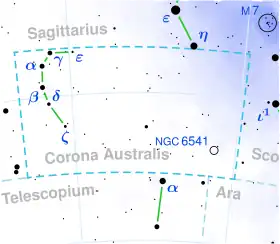 | |
| Observation data Epoch J2000.0 Equinox J2000.0 (ICRS) | |
|---|---|
| Constellation | Corona Australis |
| Right ascension | 18h 22m 18.57340s[1] |
| Declination | −38° 39′ 24.8261″[1] |
| Apparent magnitude (V) | 5.07±0.01[2] |
| Characteristics | |
| Spectral type | K4/5 III[3] |
| B−V color index | +1.49[4] |
| Astrometry | |
| Radial velocity (Rv) | 17.8±2.8[5] km/s |
| Proper motion (μ) | RA: −41.570 mas/yr[1] Dec.: −29.379 mas/yr[1] |
| Parallax (π) | 6.7176 ± 0.1706 mas[1] |
| Distance | 490 ± 10 ly (149 ± 4 pc) |
| Absolute magnitude (MV) | −0.76[6] |
| Details | |
| Mass | 1.18[7] M☉ |
| Radius | 43.6±2.2[8] R☉ |
| Luminosity | 666+44 −40[1] L☉ |
| Surface gravity (log g) | 1.34[7] cgs |
| Temperature | 4,148±122[9] K |
| Metallicity [Fe/H] | −0.13±0.01[10] dex |
| Rotational velocity (v sin i) | 1.9±1.3[11] km/s |
| Other designations | |
| Database references | |
| SIMBAD | data |
HD 168592, also designated as HR 6862 or rarely 7 G. Coronae Australis, is a solitary star[14] located in the southern constellation Corona Australis. It is faintly visible to the naked eye as an orange-hued star with an apparent magnitude of 5.07. Gaia DR3 parallax measurements place it at a distance of 490 light years[1] and is currently receding with a heliocentric radial velocity of 18 km/s.[5] At its current distance, HD 168592's brightness is diminished by 0.38 magnitudes due to interstellar dust.[15] It has an absolute magnitude of −0.76.[6]
HD 168592 has a stellar classification of K4/5 III,[3] indicating that it is an evolved K-type star with the characteristics of a K4 and K5 giant star. It has a comparable mass to the Sun[7] but the star has expanded to 43.6 times the Sun's radius.[8] It radiates 666 times the luminosity of the Sun[1] from its enlarged photosphere at an effective temperature of 4,148 K.[9] HD 168592 is slightly metal deficient with an iron abundance 26% below solar levels.[10] The star spins slowly, as is common for giant stars, with a projected rotational velocity of 1.9 km/s.[11]
References
- 1 2 3 4 5 6 7 8 Vallenari, A.; et al. (Gaia collaboration) (2023). "Gaia Data Release 3. Summary of the content and survey properties". Astronomy and Astrophysics. 674: A1. arXiv:2208.00211. Bibcode:2023A&A...674A...1G. doi:10.1051/0004-6361/202243940. S2CID 244398875. Gaia DR3 record for this source at VizieR.
- ↑ Høg, E.; Fabricius, C.; Makarov, V. V.; Urban, S.; Corbin, T.; Wycoff, G.; Bastian, U.; Schwekendiek, P.; Wicenec, A. (March 2000). "The Tycho-2 catalogue of the 2.5 million brightest stars". Astronomy and Astrophysics. 355: L27–L30. Bibcode:2000A&A...355L..27H. ISSN 0004-6361.
- 1 2 Houk, N. (1982). Michigan Catalogue of Two-dimensional Spectral Types for the HD stars. Volume III: Declinations −40° to −26°. Bibcode:1982mcts.book.....H.
- ↑ Corben, P. M.; Stoy, R. H. (1968). "Photoelectric Magnitudes and Colours for Bright Southern Stars". Monthly Notes of the Astronomical Society of South Africa. 27: 11. Bibcode:1968MNSSA..27...11C. ISSN 0024-8266.
- 1 2 Gontcharov, G. A. (November 2006). "Pulkovo Compilation of Radial Velocities for 35,495 Hipparcos stars in a common system". Astronomy Letters. 32 (11): 759–771. arXiv:1606.08053. Bibcode:2006AstL...32..759G. doi:10.1134/S1063773706110065. eISSN 1562-6873. ISSN 1063-7737. S2CID 119231169.
- 1 2 Anderson, E.; Francis, Ch. (May 2012). "XHIP: An extended hipparcos compilation". Astronomy Letters. 38 (5): 331–346. arXiv:1108.4971. Bibcode:2012AstL...38..331A. doi:10.1134/S1063773712050015. eISSN 1562-6873. ISSN 1063-7737. S2CID 119257644.
- 1 2 3 Anders, F.; et al. (August 2019). "Photo-astrometric distances, extinctions, and astrophysical parameters for Gaia DR2 stars brighter than G = 18". Astronomy & Astrophysics. 628: A94. arXiv:1904.11302. Bibcode:2019A&A...628A..94A. doi:10.1051/0004-6361/201935765. eISSN 1432-0746. ISSN 0004-6361.
- 1 2 Kervella, P.; Thévenin, F.; Di Folco, E.; Ségransan, D. (October 2004). "The angular sizes of dwarf stars and subgiants". Astronomy & Astrophysics. 426 (1): 297–307. arXiv:astro-ph/0404180. Bibcode:2004A&A...426..297K. doi:10.1051/0004-6361:20035930. eISSN 1432-0746. ISSN 0004-6361.
- 1 2 Stassun, Keivan G.; et al. (9 September 2019). "The Revised TESS Input Catalog and Candidate Target List". The Astronomical Journal. 158 (4): 138. arXiv:1905.10694. Bibcode:2019AJ....158..138S. doi:10.3847/1538-3881/ab3467. eISSN 1538-3881. hdl:1721.1/124721. S2CID 166227927.
- 1 2 Poggio, E.; Recio-Blanco, A.; Palicio, P. A.; Re Fiorentin, P.; de Laverny, P.; Drimmel, R.; Kordopatis, G.; Lattanzi, M. G.; Schultheis, M.; Spagna, A.; Spitoni, E. (30 September 2022). "The chemical signature of the Galactic spiral arms revealed by Gaia DR3". Astronomy & Astrophysics. 666: L4. arXiv:2206.14849. Bibcode:2022A&A...666L...4P. doi:10.1051/0004-6361/202244361. eISSN 1432-0746. ISSN 0004-6361.
- 1 2 De Medeiros, J. R.; Alves, S.; Udry, S.; Andersen, J.; Nordström, B.; Mayor, M. (January 2014). "A catalog of rotational and radial velocities for evolved stars". Astronomy & Astrophysics. 561: A126. arXiv:1312.3474. Bibcode:2014A&A...561A.126D. doi:10.1051/0004-6361/201220762. eISSN 1432-0746. ISSN 0004-6361.
- ↑ Gould, Benjamin Apthorp (1878). "Uranometria Argentina : brillantez y posicion de las estrellas fijas, hasta la septima magnitud, comprendidas dentro de cien grados del polo austral : con atlas". Resultados del Observatorio Nacional Argentino. 1. Bibcode:1879RNAO....1.....G.
- ↑ "HD 168592". SIMBAD. Centre de données astronomiques de Strasbourg. Retrieved December 22, 2022.
- ↑ Eggleton, P. P.; Tokovinin, A. A. (11 September 2008). "A catalogue of multiplicity among bright stellar systems". Monthly Notices of the Royal Astronomical Society. 389 (2): 869–879. arXiv:0806.2878. Bibcode:2008MNRAS.389..869E. doi:10.1111/j.1365-2966.2008.13596.x. eISSN 1365-2966. ISSN 0035-8711. S2CID 14878976.
- ↑ Gontcharov, George A.; Mosenkov, Aleksandr V. (28 September 2017). "Verifying reddening and extinction for Gaia DR1 TGAS main sequence stars". Monthly Notices of the Royal Astronomical Society. 472 (4): 3805–3820. arXiv:1709.01160. Bibcode:2017MNRAS.472.3805G. doi:10.1093/mnras/stx2219. eISSN 1365-2966. ISSN 0035-8711.